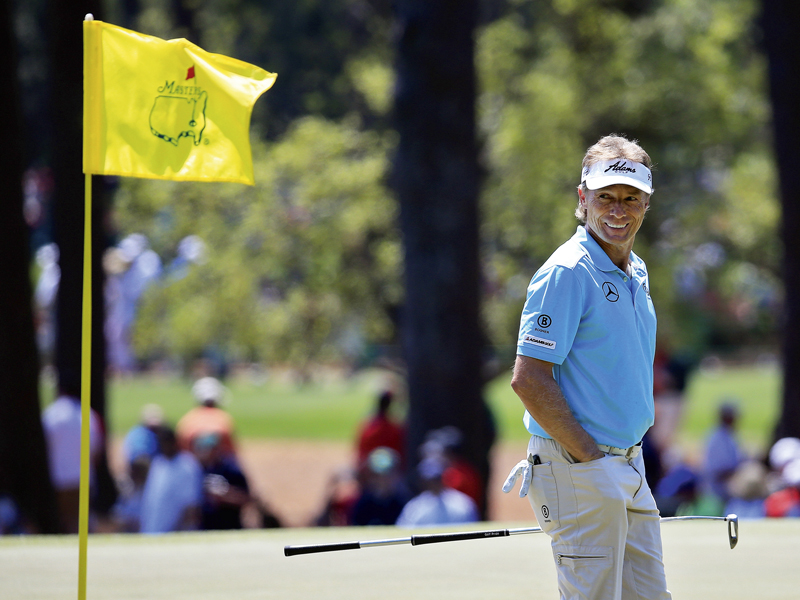Bernhard Langer’s Guide to Augusta
Bernhard Langer gives us his hole-by-hole guide to Augusta National


Two-time Masters champion Bernhard Langer knows the course at Augusta National better than most. He gives us his hole-by-hole guide...
Bernhard Langer knows the golf course at Augusta National better than most. The German – Masters champion in 1985 and 1993 – made his Augusta debut in 1982 and he will be making his 34th Masters appearance this year. Among European golfers, only Sandy Lyle has appeared in more Masters tournaments (34 up to 2015) although Langer, 58, has made more cuts and played more Masters rounds; 110 to Lyle’s 102. No other European golfers have played 100 rounds in The Masters. Here is Langer’s hole-by-hole guide to playing Augusta National:
1. Tea Olive 445 yds, par 4 The first priority is to avoid the right-hand fairway bunker, and then wind direction dictates how much club you need to reach the green. You must avoid going long or left and ideally you want to set up an uphill putt.
2. Pink Dogwood 575 yds, par 5 The driving line is left of the bunker on the right. As it’s downhill the green is within reach but because it’s so severe and narrow it’s no bad thing to be in a front bunker for two or to have a full pitch into the green.
Subscribe to the Golf Monthly newsletter to stay up to date with all the latest tour news, equipment news, reviews, head-to-heads and buyer’s guides from our team of experienced experts.
3. Flowering Peach 350 yds, par 4 A short par 4 but the green is only about 11 yards deep on the left. The second shot can spin down the slope in front of the green or go through the back, so short-iron precision is vital.
4. Flowering Crab Apple 240 yds, par 3 This is a difficult par 3 because the hole plays so long it can be hard to generate height and distance. It is better to be in the front bunker than past the flag.
5. Magnolia 455 yds, par 4 The 5th green is extremely difficult so as much distance as possible off the tee means you can play into the green with the height you need to stop the ball quickly. A nearly perfect second shot can finish 50 feet from the hole.
6. Juniper 180 yds, par 3 A great par 3, but perhaps too severe with the top-right-corner pin position. You need to stop a long-iron tee shot on an area that is roughly ten yards deep and eight yards wide.
7. Pampas 450 yds, par 4 This hole demands a long, straight tee shot through the trees. Real precision is then key on the approach to find the right part of the elevated green.
8. Yellow Jasmine 570 yds, par 5 This uphill par 5 plays so long that it is very difficult to find the right part of the green with the second shot. There is a severe slope in the middle of the green so even approaching with a wedge requires great accuracy.
9. Carolina Cherry 460 yds, par 4 Drives must be drawn from right to left or they will find the trees. Even the perfect shot leaves a difficult second from a downhill lie to an uphill green. If you’re short the ball could run back down the fairway for 60 or 70 yards.

10. Camellia 495 yds, par 4 This is another tee shot that demands a draw. The fairway falls to the left side and catching the slope means you can take more loft into the green. Problems from the left of the fairway often come from overhanging branches.
11. White Dogwood 505 yds, par 4 This used to be one of golf’s widest fairways but now with trees on the right and the tee pushed back it is one of the hardest driving holes. With water left of the green, aim perhaps ten yards on from the green’s right edge. Try to make par and get out of there!
12. Golden Bell 155 yds, par 3 The green is angled from front-left to back-right and so is Rae’s Creek. Due to the swirling winds I, like Jack Nicklaus, play over the bunker, even though the landing area is only about nine yards deep.
13. Azalea 510 yds, par 5 I love this hole, it’s classic ‘risk and reward’. The tee shot needs to hook around and hug the left of the fairway by the creek because that shortens the second shot and gives you a flatter lie. Even then the second shot is played with the ball above your feet.
14. Chinese Fir 440 yds, par 4 With the fairway sloping from left to right, another hook helps here as long as you set it off on the right line. Wind direction and pin placement dictate what club to take next, hitting into one of the hardest greens on the whole of the course.
15. Firethorn 530 yds, par 5 It takes two great strikes to carry the water and reach the green in two, but even then it is very easy for the ball to skip through. Golfers can still birdie with a precise wedge approach. A great risk-and-reward hole.
16. Redbud 170 yds, par 3 The water on the left tempts you to aim for the right half of the green but that can leave a wicked, curling putt if the pin is low and left. You want to avoid putting with your back to the hole – it can happen.
17. Nandina 440 yds, par 4 This hole is more straightforward since the Eisenhower Tree came down two years ago. There is more room off the tee but the green can get very slick, especially on the right.
18. Holly 465 yds, par 4 This tee shot is one of golf’s tightest and requires decent length. The key is to hit a slight fade for the dogleg, then it could be a mid-iron or a much longer club to the elevated, two-tier green, depending on the pin and the wind. There is a birdie chance if you find the right plateau.
- Bernhard Langer is a brand ambassador for Mercedes-Benz. Mercedes-Benz is a global sponsor of The Masters.
David joined Golf Monthly in 2015 as a content editor for the magazine and regularly contributes to the website. He has worked in magazine publishing and editing since 2003. He is a keen golfer and up until recently was a member of Blackmoor Golf Club in Hampshire. He has covered various big events and tournaments for GM, the highlight of which was witnessing Tiger Woods win his 15th Major at Augusta in 2019. Email: david.taylor@futurenet.com
